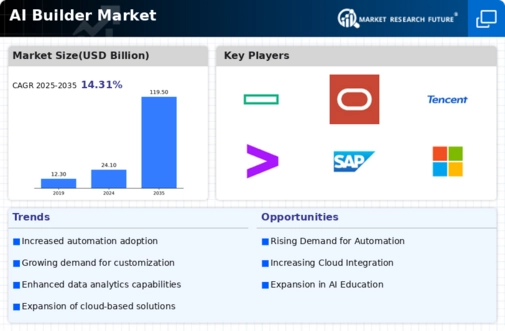Rising Demand for Automation
The AI Builder Market is experiencing a notable surge in demand for automation solutions across various sectors. Organizations are increasingly seeking to streamline operations, reduce costs, and enhance efficiency through automation. According to recent data, the automation market is projected to reach a value of approximately 200 billion dollars by 2026, indicating a robust growth trajectory. This trend is driving the adoption of AI builder tools that enable businesses to create automated workflows without extensive coding knowledge. As companies recognize the potential of AI-driven automation to improve productivity and decision-making, the AI Builder Market is likely to witness accelerated growth.
Growing Emphasis on User Experience
User experience is emerging as a pivotal factor in the AI Builder Market. As businesses strive to create intuitive and engaging applications, the demand for AI builder tools that prioritize user-centric design is increasing. Companies are recognizing that a seamless user experience can significantly impact customer satisfaction and retention. The market for user experience design is projected to grow substantially, with estimates suggesting it could reach 100 billion dollars by 2027. This trend is prompting AI builder platforms to incorporate features that enhance usability, thereby attracting a broader range of users and driving growth within the AI Builder Market.
Enhanced Data Analytics Capabilities
In the AI Builder Market, the ability to harness and analyze vast amounts of data is becoming increasingly critical. Organizations are leveraging AI builder tools to develop sophisticated analytics solutions that provide actionable insights. The AI Builder is expected to exceed 300 billion dollars by 2025, reflecting a growing emphasis on data-driven decision-making. AI builders facilitate the creation of custom analytics applications, allowing businesses to tailor solutions to their specific needs. This trend underscores the importance of integrating advanced analytics capabilities into AI builder platforms, thereby enhancing their value proposition in the market.
Integration of AI with Cloud Technologies
The convergence of AI and cloud technologies is reshaping the AI Builder Market. As organizations migrate to cloud-based solutions, the demand for AI builder tools that can seamlessly integrate with cloud platforms is on the rise. This integration allows for enhanced scalability, flexibility, and accessibility of AI applications. The cloud computing market is anticipated to surpass 800 billion dollars by 2025, indicating a robust growth environment for AI builders that leverage cloud capabilities. This trend suggests that AI builder platforms that offer cloud integration will likely gain a competitive edge, further propelling the growth of the AI Builder Market.
Increased Focus on Security and Compliance
Security and compliance are becoming paramount concerns within the AI Builder Market. As organizations adopt AI solutions, they must navigate complex regulatory landscapes and ensure data protection. The market for cybersecurity solutions is projected to reach 300 billion dollars by 2024, highlighting the critical need for secure AI applications. AI builder tools that incorporate robust security features and compliance frameworks are likely to attract more users, as businesses prioritize safeguarding sensitive information. This focus on security not only enhances trust in AI solutions but also drives innovation within the AI Builder Market, as developers seek to create compliant and secure applications.


















Leave a Comment